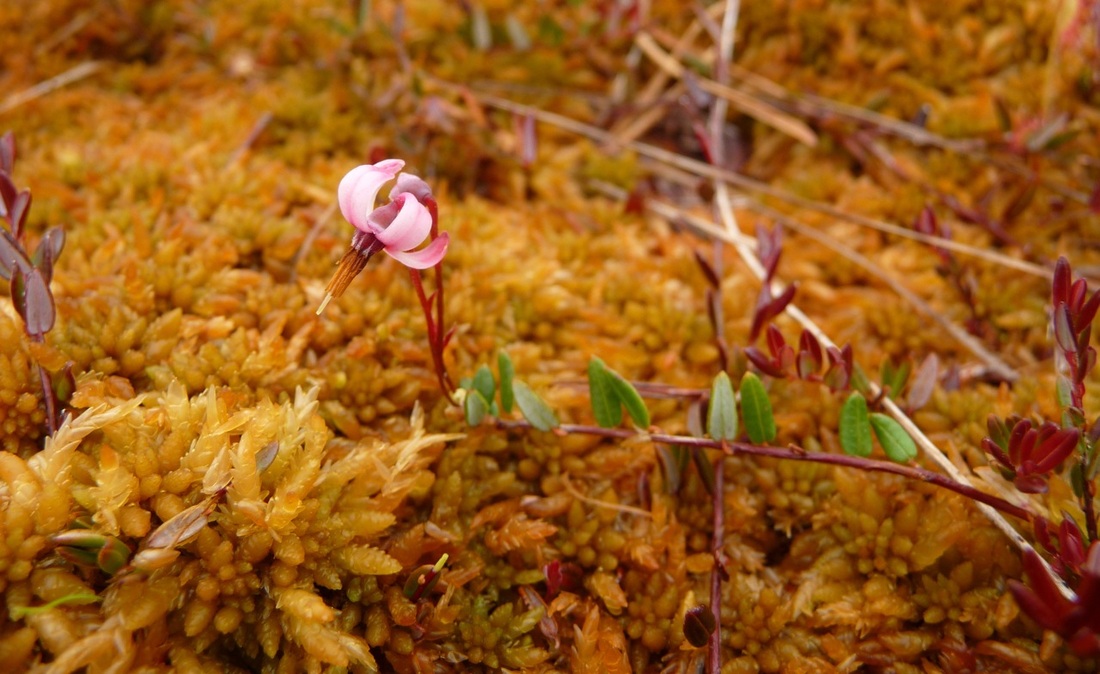Bog cranberry • Oxycoccus oxycoccos, Vaccinium oxycoccos
Identification
Bog cranberry is a small creeping shrub, appearing in single to densely clustered stalks as a ground cover. It has small evergreen leaves (3-10 mm) with a leathery texture and alternating growth pattern. They are deep green and shiny on the surface, grey-waxy underneath, and have rolled under edges. The flowers look like tiny shooting stars, with four deep pink petals sharply pointed backwards and stamens prominently protruding downwards. These flowers typically grow singly on stems, but sometimes appear in twos or threes. The berries are small and pink to red, 5-12 mm wide and shiny smooth. Bog cranberry tends to fruit between August and October, with some winter persistence.
Habitat & Range
Found from Alaska to the east coast and down into New England, the Great Lakes, and Oregon. Prefers boggy, moist conditions and often grows in Sphagnum hummocks and in wet subalpine meadows.
Similar Species
Bog cranberry has many taxonomic names: Vaccinium oxycoccus, V. microcarpum, O. microcarpus, and O. quadripetalus. There is contention over whether the group has two species, and whether it fits under the Vaccinium genus. For more information, see the E-Flora database record. Vaccinium vitis-idaea is another local cranberry that can be distinguished by its large leaves (up to 1 cm) and dark spots on the leaf underside.
Human Uses
The berries are a traditional food source of many coastal First Nations; preparation and preservation techniques include cooking the berries and serving them in oolichan grease, drying them in cakes, and storing them fresh in moss.
Bog cranberry is a small creeping shrub, appearing in single to densely clustered stalks as a ground cover. It has small evergreen leaves (3-10 mm) with a leathery texture and alternating growth pattern. They are deep green and shiny on the surface, grey-waxy underneath, and have rolled under edges. The flowers look like tiny shooting stars, with four deep pink petals sharply pointed backwards and stamens prominently protruding downwards. These flowers typically grow singly on stems, but sometimes appear in twos or threes. The berries are small and pink to red, 5-12 mm wide and shiny smooth. Bog cranberry tends to fruit between August and October, with some winter persistence.
Habitat & Range
Found from Alaska to the east coast and down into New England, the Great Lakes, and Oregon. Prefers boggy, moist conditions and often grows in Sphagnum hummocks and in wet subalpine meadows.
Similar Species
Bog cranberry has many taxonomic names: Vaccinium oxycoccus, V. microcarpum, O. microcarpus, and O. quadripetalus. There is contention over whether the group has two species, and whether it fits under the Vaccinium genus. For more information, see the E-Flora database record. Vaccinium vitis-idaea is another local cranberry that can be distinguished by its large leaves (up to 1 cm) and dark spots on the leaf underside.
Human Uses
The berries are a traditional food source of many coastal First Nations; preparation and preservation techniques include cooking the berries and serving them in oolichan grease, drying them in cakes, and storing them fresh in moss.
References
Pojar, J. and MacKinnon, A. (1994). Plants of Coastal British Columbia. Vancouver, BC: Lone Pine Publishing. P. 58.
Klein, K. (2003). Plant Data Sheet: Vaccinium oxycoccus. College of Forest Resources, University of Washington, Washington, Seattle. Accessed 22/08/2014.
Vaccinium oxycoccos (L.) MacMill. . In Klinkenberg, Brian. (Ed.). E-Flora BC: Electronic Atlas of the Plants of British Columbia. Lab for Advanced Spatial Analysis, Department of Geography, University of British Columbia, Vancouver. Accessed 22/08/2014.
Authors and editors of page
Nancy Shackelford and Brian Starzomski (2014).
Pojar, J. and MacKinnon, A. (1994). Plants of Coastal British Columbia. Vancouver, BC: Lone Pine Publishing. P. 58.
Klein, K. (2003). Plant Data Sheet: Vaccinium oxycoccus. College of Forest Resources, University of Washington, Washington, Seattle. Accessed 22/08/2014.
Vaccinium oxycoccos (L.) MacMill. . In Klinkenberg, Brian. (Ed.). E-Flora BC: Electronic Atlas of the Plants of British Columbia. Lab for Advanced Spatial Analysis, Department of Geography, University of British Columbia, Vancouver. Accessed 22/08/2014.
Authors and editors of page
Nancy Shackelford and Brian Starzomski (2014).




